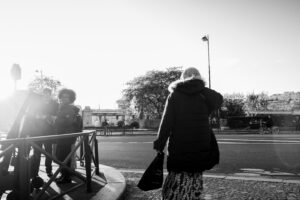
As an amateur photographer, I often wonder how to position my practice. Between simple use to create a memory, the desire to accentuate the artistic side and the desire to transform my practice into a lucrative professional activity, it’s not uncommon to find myself at a loss as to where to place myself. Let’s be honest, there’s a big difference between taking photos for pleasure and trying to make money from them.
My experience in the world of amateur photography has enabled me to discover the challenges inherent in this practice while exploring ways of monetizing my work. I tried several solutions, several positions, for relatively meager returns. At the very least, the point of this wandering is to force myself to explore different horizons.
In this article, I share a few snippets of my journey, highlighting the challenges and opportunities I’ve encountered in trying to evolve my amateurism towards, if not professionalism, more quality and working on the artistic side. If you’re like me, if you love capturing moments with your camera but don’t know exactly how to position yourself, then my experiences should give you some food for thought. This is just my experience, but it could be useful to others.
Foreword, the equipment
Before delving into some of the details of my journey into amateur photography and monetization, allow me to introduce you to my equipment of choice: the camera Fujifilm XT3 and the lens Fujifilm XF 18-55mm F2.8-4. This is a kitconfiguration but the whole is interesting.
With this duo, I discover the world of photography with exceptional simplicity and precision. It’s versatile and light enough to adapt to a wide range of situations.
On-demand services
I’m starting with this one because it’s an area I haven’t explored. I was contacted a few times following my debut on Instagram and rarely responded. For me, the time investment seemed excessive and I didn’t feel relevant until I’d found my style. Imposter syndrome, so to speak!
So why tell you about it? Because I can nonetheless point out that, without looking, a few contacts arrived in my messages. So it seems possible that, with the right communication and a certain amount of targeting, I could find some contracts.
The question remains: why? Many people explain that the “wedding photography” stage is necessary to make a name for oneself and get started… I simply don’t feel motivated by this prospect.
Selling on stock photography
As I explored different ways of monetizing my passion for photography, I also discovered the world of online image banks. How could I ignore it?
These platforms offer amateur photographers like me the chance to upload and sell their shots to a wide audience, from bloggers and content creators to businesses looking for unique, high-quality images. Uploading my photos to these platforms has not only enabled me to reach a global audience, but also to generate an income from my work, with each upload resulting in a small commission. I’ve tested a lot of them, maybe too many. But then it’s easy to sort out and target the ones that seem to have the most potential.
Here’s an example of these platforms with my portfolio on Adobe Stock or Shutterstock. Although the competition on these platforms is fierce and it’s sometimes difficult to stand out among the multitude of images available, it has encouraged me to hone my skills and explore new photographic subjects and styles to meet the changing needs of the market.
Some people are negative about the remuneration policy, of course! But I prefer to keep the glass half-full, motivate myself and force myself to work on my technique.
Sales of printed photographs
Another exciting approach I’ve explored is selling prints. By offering prints of my images, I’ve been able to share my work with a public that prefers tangible works to display in their homes. This has clearly opened up a whole new horizon in which I can project myself towards a more artistic style. As opposed to the formalism and polished style expected on image banks, there are no limits this time.
Selling prints has added a tangible dimension to my work, offering the possibility of reaching out to art lovers and collectors. I chose to work with a single partner and not develop my own sales platform. My photographs are available on La Boutique du Poster. Instagram allowed me to make myself known to the platform’s owner and to embark on this great adventure.

I’m still in the early stages of this business of selling prints, but although it’s not very lucrative at the moment, it’s clearly giving me a new lease of life. My motivation is increased tenfold by the desire to break through. This approach has enabled me to make contacts and become part of a community that allows me to learn more quickly.
And the latest trend…
Which one is it? No clue? I’m talking about NFT! And yes, I’ve also tried it on this platform.
A recent trend in the world of photography and digital art is the emergence of NFTs, or non-fungible tokens. NFTs offer photographers a new way of monetizing their work by tokenizing it on decentralized blockchain-based platforms. By creating NFTs of their work, photographers can assign a unique value and authenticate their ownership, offering potential buyers the chance to own an exclusive digital piece.
That’s the theory, but in practice, prepare to plunge into an obscure universe. Defenders will say that I haven’t understood anything, to which I would reply that when you don’t do anything simple and clear… it’s complicated!
That doesn’t mean you shouldn’t go for it, but arm yourself with the patience to figure out how to break through. After all, it’s not so much the computerized and dematerialized aspect that’s confusing, but rather the need to grasp the communication mechanisms and codes of this new world in order to make a name for yourself. There’s no doubt that this technology has opened up new opportunities for photographers to sell their creations directly to collectors, without going through traditional intermediaries.

Conclusion
The road is long and difficult, but the motivation is always there. The most important thing is balance, knowing from the outset that it’s going to take time and that you need to have some other escape routes and engines on the side. At least, that’s how I approached it. By not putting all my energy into it, I’m depriving myself of opportunities, but it’s a good way of preserving myself and avoiding frustration.
Don’t hesitate to share your vision or contact me to discuss it!
